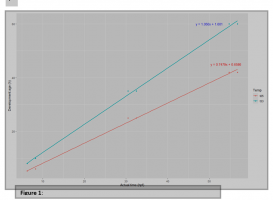jakerm1995
New member
- Joined
- Feb 23, 2022
- Messages
- 5
I have two line equations representing two temperatures:
Temperature 25C: y= 0.7479x + 0.6586
Temperature 33C: y= 1.050x + 1.601
I am tasked with using these to work out the difference in development rates of a particular species under each temperature. Y= development time and x=Time. I am confused with how to use these two equations to calculate the difference in growth rate. As when I apply a percentage increase calculation to temperature 33, I calculate an 87% increase over 10 hours, and with the 25C i see a 92% increase over 10 hours. It should be that the 33C has a higher development rate and so my calculations must be wrong :/ I am very confused. I will post the graph here so you can understand better. Any suggestions are much appreciated (bare in mind, I am a noob at maths).

Temperature 25C: y= 0.7479x + 0.6586
Temperature 33C: y= 1.050x + 1.601
I am tasked with using these to work out the difference in development rates of a particular species under each temperature. Y= development time and x=Time. I am confused with how to use these two equations to calculate the difference in growth rate. As when I apply a percentage increase calculation to temperature 33, I calculate an 87% increase over 10 hours, and with the 25C i see a 92% increase over 10 hours. It should be that the 33C has a higher development rate and so my calculations must be wrong :/ I am very confused. I will post the graph here so you can understand better. Any suggestions are much appreciated (bare in mind, I am a noob at maths).


